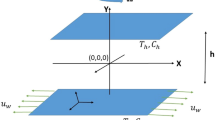Abstract
In this paper, the flow of a visco-elastic liquid between two parallel plates has been studied when one plate is stationary and the other plate suddenly starts oscillating. Both finite Fourier sine transform and Laplace transform technique have been employed to solve the basic differential equations. The flow phenomenon has been characterized by the parametersα, β andω and the effects of these on the flow characteristics have been studied through several graphs.
Similar content being viewed by others
References
Rayleigh, L., Phil. Mag. (6)21, 697 (1911).
Tanner, R. I., ZAMP13, 573 (1962).
Soundalgekar, V. M., Rheol. Acta13, 117 (1974).
Schlichting, H., Boundary Layer Theory, 6th Edition, pp. 83, McGraw Hill (1968).
Oldroyd, J. G., Proc. Roy. Soc. Lond.200A, 523 (1950).
Sneddon, I. N., Fourier Transform, McGraw Hill Book Company (1951).
Author information
Authors and Affiliations
Additional information
Late professor of the department, who died in an accident on 7th July 1978.
Rights and permissions
About this article
Cite this article
Mishra, S.P., Misra, K.C. Visco-elastic flow due to a plate which starts oscillating in the presence of a parallel stationary plate. Rheol Acta 21, 25–29 (1982). https://doi.org/10.1007/BF01520702
Received:
Issue Date:
DOI: https://doi.org/10.1007/BF01520702




